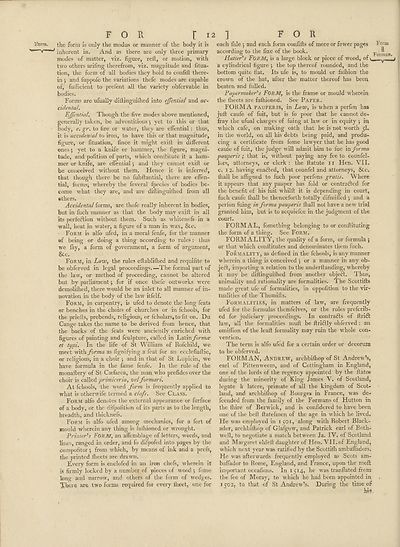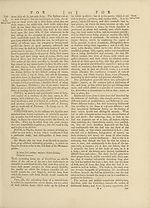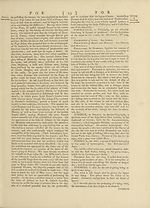Encyclopaedia Britannica, or, a Dictionary of arts, sciences, and miscellaneous literature : enlarged and improved. Illustrated with nearly six hundred engravings > Volume 9, FOR-GOT
(20) Page 12
Download files
Complete book:
Individual page:
Thumbnail gallery: Grid view | List view

F O Ft
r 12
the form is only the modus or manner of the body it is
inherent in. And as there are only three primary
modes of matter, viz. figure, reft, or motion, with
two others ariiing therefrom, viz. magnitude and fitua-
tion, the form of all bodies they hold to confift there¬
in } and fuppofe the variations thefe modes are capable
of, fufficient to prefent all the variety obfervable in
bodies.
Forms are ufually diftinguiftied into cjfential and ac-
cidental.
EJfential. Though the five modes above mentioned,
generally taken, be adventitious •, yet to this or that
body, e. gr. to fire or water, they are effential : thus,
it is accidental to iron, to have this or that magnitude,
figure, or fituation, fince it might exift in different
ones *, yet to a knife or hammer, the figure, magni¬
tude, and pofition of parts, which conilitute it a ham¬
mer or knife, are efiential •, and they cannot exift or
be conceived without them. Hence it is inferred,
that though there be no fubftantial, there are effen¬
tial, forms, whereby the feveral fpecies of bodies be¬
come what they are, and are diftinguiftied from all
»thers.
Accidental forms, are thofe really inherent in bodies,
but in fuch manner as that the body may exift in all
its perfection without them. Such as whitenefs in a
wall, heat in water, a figure of a man in wax, &c.
Form is alfo ufed, in a moral fenfe, for the manner
»f being or doing a thing according to rules : thus
we fay, a form of government, a form of argument,
See.
Form, in the rules eftablifhed and requifite to
be obferved in legal proceedings.—The formal part of
the law, or method of proceeding, cannot be altered
but by parliament; for if once thefe outworks were
demolilhed, there -would be an inlet to all manner of in¬
novation in the body of the law itfelf.
Form, in carpentry, is ufed to denote the long feats
or benches in the choirs of churches or in fchools, for
the priefts, prebends, religious, or fcholars,to fit on. Du
Cange takes the name to be derived from hence, that
the backs of the feats were anciently enriched with
figures of painting and fculpture, called in Latin fornue
ct tijpi. In the life of St William of Rofcbild, we
meet with forma as fignifying a feat for an ecclefiaftic,
or religious, in a choir ; and in that of St Lupicin, we
have formula in the fame fenfe. In the rule of the
monaftery of St Csefarea, the man who prefides over the
choir is called primiceria, vel formari.
At fchools, the word form is frequently applied to
what is other-wife termed a clafs. See Class.
Form alfo denotes the external appearance or furface
of a body, or the difpofition of its parts as to the length,
breadth, and thicknefs.
Form is alfo ufed among mechanics, for a fort of
mould wherein any thing is faflnoned or wrought.
Printers FORM, an afferablage of letters, words, and
line1-, ranged in order, and fo difpofed into pages by the
compofitor •, from which, by means of ink and a prefs,
the printed (beets are drawn.
Every form is enclofed in an iron chefs, wherein it
is firmly locked by a number of pieces of wood 5 feme
long and narrow, and others of the form of wedges.
'Jbeie are two forms required for every (heet, one for
] FOR
each fide ; and each form confifts of more or fewer pages
according to the fize of the book.
Hatter's FORM, is a large block or piece of wood, of i.
a cylindrical figure j the top thereof rounded, and the
bottom quite fiat. Its ufe is, to mould or falhion the
crown of the hat, after the matter thereof has been
beaten and fulled.
Papermaker's FORM, is the frame or mould wherein
the (beets are fafhioned. See Paper.
FORMA pauperis, in Law, is when a perfon has
juft caufe of fuit, but is fo poor that he cannot de¬
fray the ufual charges of fuing at law or in equity ; in
which cafe, on making oath that he is not rvorth 5I.
in the world, on all his debts being paid, and produ¬
cing a certificate from fome lawyer that he has good
cauie of (bit, the judge will admit him to fue in jorma
pauperis ; that is, without paying any fee to counfel-
lors, attorneys, or clerk: the ftatute 11 Hen. VII.
c. 1 2. having enabled, that counfel and attorneys, &e.
(hall be afligned to fuch poor perfons gratis. Where
it appears that any pauper has fold or contrabfed for
the benefit of his fuit whilft it is depending in court,
fuch eaufe (hall be thenceforth totally difmiffed ; and a
perfon fuing in forma pauperis (hall not have a new trial
granted him, but is to acquiefce in the judgment of the
court.
FORMAL, fomething belonging to or conftituting
the form of a thing. See Form.
FORMALITY, the quality of a form, or formula \
or that which conftitutes and denominates them fuch.
Formality, as defined in the fchools, is any manner
wherein a thing is conceived ; or a manner in any ob-
jebl, importing a relation to the under (landing-, whereby
it may be diftinguiftied from another objebt. Thus,
animality and rationality are formalities. The Scottifts
made great ufe of formalities, in oppofition to the vir¬
tualities of the Thomifts.
Formalities, in matters of law, are frequently
ufed for the formulas themfelves, or the rules preferib-
ed for judiciary proceedings. In contracts of drift
law, all the formalities muft be ftriftly obferved : an
omiftion of the lead formality may ruin the whole con¬
vention.
The term is alfo ufed for a certain order or decorum
to be obferved.
FORMAN, Andrew, arehbiftiop of St Andrew’s,
earl of Pittenweem, and of Cottingham in England,
one of the lords of the regency appointed by the (fates
during the minority of King James \. of Scotland,
legate a latere, primate of all the kingdom of Scot¬
land, and archbiftiop of Eourges in France, was de-
feended from the family of the Formans of Hutton in
the (hire of Berwick, and is confidered to have been
one of the beft ftatefmen of the age in which he lived.
He was employed in 1 i;oi, along with Robert Black-
ader, archbiftiop of Glafgow, and Patrick earl of Both-
well, to negotiate a match between Ja. IV. of Scotland
and Margaret eldeft daughter of Hen. VII. of England,
which next year w as ratified by the Scottifti ambafladors.
He was afterwards frequently employed as Scots am-
baffador to Rome, England, and France, upon the mod
important occafions. In 1514, he was tranfiated from
the fee of Moray, to which he had been appointed in
1502, to that of St Andrew’s. During the time of
hi1?
Form
Forman,
r 12
the form is only the modus or manner of the body it is
inherent in. And as there are only three primary
modes of matter, viz. figure, reft, or motion, with
two others ariiing therefrom, viz. magnitude and fitua-
tion, the form of all bodies they hold to confift there¬
in } and fuppofe the variations thefe modes are capable
of, fufficient to prefent all the variety obfervable in
bodies.
Forms are ufually diftinguiftied into cjfential and ac-
cidental.
EJfential. Though the five modes above mentioned,
generally taken, be adventitious •, yet to this or that
body, e. gr. to fire or water, they are effential : thus,
it is accidental to iron, to have this or that magnitude,
figure, or fituation, fince it might exift in different
ones *, yet to a knife or hammer, the figure, magni¬
tude, and pofition of parts, which conilitute it a ham¬
mer or knife, are efiential •, and they cannot exift or
be conceived without them. Hence it is inferred,
that though there be no fubftantial, there are effen¬
tial, forms, whereby the feveral fpecies of bodies be¬
come what they are, and are diftinguiftied from all
»thers.
Accidental forms, are thofe really inherent in bodies,
but in fuch manner as that the body may exift in all
its perfection without them. Such as whitenefs in a
wall, heat in water, a figure of a man in wax, &c.
Form is alfo ufed, in a moral fenfe, for the manner
»f being or doing a thing according to rules : thus
we fay, a form of government, a form of argument,
See.
Form, in the rules eftablifhed and requifite to
be obferved in legal proceedings.—The formal part of
the law, or method of proceeding, cannot be altered
but by parliament; for if once thefe outworks were
demolilhed, there -would be an inlet to all manner of in¬
novation in the body of the law itfelf.
Form, in carpentry, is ufed to denote the long feats
or benches in the choirs of churches or in fchools, for
the priefts, prebends, religious, or fcholars,to fit on. Du
Cange takes the name to be derived from hence, that
the backs of the feats were anciently enriched with
figures of painting and fculpture, called in Latin fornue
ct tijpi. In the life of St William of Rofcbild, we
meet with forma as fignifying a feat for an ecclefiaftic,
or religious, in a choir ; and in that of St Lupicin, we
have formula in the fame fenfe. In the rule of the
monaftery of St Csefarea, the man who prefides over the
choir is called primiceria, vel formari.
At fchools, the word form is frequently applied to
what is other-wife termed a clafs. See Class.
Form alfo denotes the external appearance or furface
of a body, or the difpofition of its parts as to the length,
breadth, and thicknefs.
Form is alfo ufed among mechanics, for a fort of
mould wherein any thing is faflnoned or wrought.
Printers FORM, an afferablage of letters, words, and
line1-, ranged in order, and fo difpofed into pages by the
compofitor •, from which, by means of ink and a prefs,
the printed (beets are drawn.
Every form is enclofed in an iron chefs, wherein it
is firmly locked by a number of pieces of wood 5 feme
long and narrow, and others of the form of wedges.
'Jbeie are two forms required for every (heet, one for
] FOR
each fide ; and each form confifts of more or fewer pages
according to the fize of the book.
Hatter's FORM, is a large block or piece of wood, of i.
a cylindrical figure j the top thereof rounded, and the
bottom quite fiat. Its ufe is, to mould or falhion the
crown of the hat, after the matter thereof has been
beaten and fulled.
Papermaker's FORM, is the frame or mould wherein
the (beets are fafhioned. See Paper.
FORMA pauperis, in Law, is when a perfon has
juft caufe of fuit, but is fo poor that he cannot de¬
fray the ufual charges of fuing at law or in equity ; in
which cafe, on making oath that he is not rvorth 5I.
in the world, on all his debts being paid, and produ¬
cing a certificate from fome lawyer that he has good
cauie of (bit, the judge will admit him to fue in jorma
pauperis ; that is, without paying any fee to counfel-
lors, attorneys, or clerk: the ftatute 11 Hen. VII.
c. 1 2. having enabled, that counfel and attorneys, &e.
(hall be afligned to fuch poor perfons gratis. Where
it appears that any pauper has fold or contrabfed for
the benefit of his fuit whilft it is depending in court,
fuch eaufe (hall be thenceforth totally difmiffed ; and a
perfon fuing in forma pauperis (hall not have a new trial
granted him, but is to acquiefce in the judgment of the
court.
FORMAL, fomething belonging to or conftituting
the form of a thing. See Form.
FORMALITY, the quality of a form, or formula \
or that which conftitutes and denominates them fuch.
Formality, as defined in the fchools, is any manner
wherein a thing is conceived ; or a manner in any ob-
jebl, importing a relation to the under (landing-, whereby
it may be diftinguiftied from another objebt. Thus,
animality and rationality are formalities. The Scottifts
made great ufe of formalities, in oppofition to the vir¬
tualities of the Thomifts.
Formalities, in matters of law, are frequently
ufed for the formulas themfelves, or the rules preferib-
ed for judiciary proceedings. In contracts of drift
law, all the formalities muft be ftriftly obferved : an
omiftion of the lead formality may ruin the whole con¬
vention.
The term is alfo ufed for a certain order or decorum
to be obferved.
FORMAN, Andrew, arehbiftiop of St Andrew’s,
earl of Pittenweem, and of Cottingham in England,
one of the lords of the regency appointed by the (fates
during the minority of King James \. of Scotland,
legate a latere, primate of all the kingdom of Scot¬
land, and archbiftiop of Eourges in France, was de-
feended from the family of the Formans of Hutton in
the (hire of Berwick, and is confidered to have been
one of the beft ftatefmen of the age in which he lived.
He was employed in 1 i;oi, along with Robert Black-
ader, archbiftiop of Glafgow, and Patrick earl of Both-
well, to negotiate a match between Ja. IV. of Scotland
and Margaret eldeft daughter of Hen. VII. of England,
which next year w as ratified by the Scottifti ambafladors.
He was afterwards frequently employed as Scots am-
baffador to Rome, England, and France, upon the mod
important occafions. In 1514, he was tranfiated from
the fee of Moray, to which he had been appointed in
1502, to that of St Andrew’s. During the time of
hi1?
Form
Forman,
Set display mode to:
![]() Universal Viewer |
Universal Viewer | ![]() Mirador |
Large image | Transcription
Mirador |
Large image | Transcription
Images and transcriptions on this page, including medium image downloads, may be used under the Creative Commons Attribution 4.0 International Licence unless otherwise stated. ![]()
| Permanent URL | https://digital.nls.uk/193224017 |
|---|
| Attribution and copyright: |
|
|---|
| Description | Ten editions of 'Encyclopaedia Britannica', issued from 1768-1903, in 231 volumes. Originally issued in 100 weekly parts (3 volumes) between 1768 and 1771 by publishers: Colin Macfarquhar and Andrew Bell (Edinburgh); editor: William Smellie: engraver: Andrew Bell. Expanded editions in the 19th century featured more volumes and contributions from leading experts in their fields. Managed and published in Edinburgh up to the 9th edition (25 volumes, from 1875-1889); the 10th edition (1902-1903) re-issued the 9th edition, with 11 supplementary volumes. |
|---|---|
| Additional NLS resources: |
|

